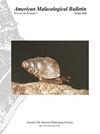墨西哥湾北部大型钙质Thecosome翼龙的丰度和分布
IF 0.4
4区 生物学
Q4 MARINE & FRESHWATER BIOLOGY
引用次数: 0
摘要
摘要:大型软体翼足类动物在墨西哥湾北部远洋生态系统中的生态作用可能是巨大的,无论是在食物网还是生物地球化学循环中。我们分析了带有钙质外壳的大型物种(收集在3毫米网中的物种)的物种丰度、垂直和水平分布。2010年深水地平线石油(DWH)泄漏后,通过两个中层水采样项目收集了翼龙化石样本:近海奈克顿采样和分析项目(ONSAP2011)和墨西哥湾深海奈克顿动力学项目(DEEPEND2015)。所有样本均使用10m2多开/关网和环境传感系统(MOC10)中层水域拖网收集,网眼为3mm。该装置对0–1500米之间的五个离散深度进行了采样。检查了13000多个翼足类标本,确定了25个物种。在这两个采集时期,林奈(Clio pyramidata Linnaeus 1767)是数量最多的物种。五个属(Diacria、Clio、Styliola、Cuvierina、Cavolinia)表现出从中上层到上层的昼夜垂直迁移。本文章由计算机程序翻译,如有差异,请以英文原文为准。
Abundance and Distribution of Large Calcareous Thecosome Pteropods in the Northern Gulf of Mexico
Abstract: The ecological role of large thecosome pteropods in the pelagic ecosystem of the northern Gulf of Mexico (GoM) may be substantial, both in the food web and biogeochemical cycling. We analyzed species abundances, vertical and horizontal distributions of large species with calcareous shells (those collected in 3-mm mesh nets). Pteropod samples were collected following the 2010 Deepwater Horizon oil (DWH) spill by two midwater sampling programs: the Offshore Nekton Sampling and Analysis Program (ONSAP 2011) and the Deep Pelagic Nekton Dynamics of the Gulf of Mexico (DEEPEND 2015) projects. All samples were collected using a 10-m2 Multiple Opening/Closing Net and Environmental Sensing System (MOC10) midwater trawl, with 3-mm mesh. This gear sampled five discrete depths between 0–1500 m. Over 13,000 pteropod specimens were examined, with 25 species identified. Clio pyramidata Linnaeus 1767 was the most abundant species during both collection periods. Five genera (Diacria, Clio, Styliola, Cuvierina, Cavolinia) demonstrated diel vertical migration from the mesoto epipelagic zone.
求助全文
通过发布文献求助,成功后即可免费获取论文全文。
去求助
来源期刊
CiteScore
1.00
自引率
40.00%
发文量
1
审稿时长
>12 weeks
期刊介绍:
The American Malacological Bulletin serves as an outlet for reporting notable contributions in malacological research. Manuscripts concerning any aspect of original, unpublished research,important short reports, and detailed reviews dealing with molluscs will be considered for publication. Recent issues have included AMS symposia, independent papers, research notes,and book reviews. All published research articles in this journal have undergone rigorous peer review, based on initial editor screening and anonymous reviewing by independent expertreferees. AMS symposium papers have undergone peer review by symposium organizer, symposium participants, and independent referees.

 求助内容:
求助内容: 应助结果提醒方式:
应助结果提醒方式:


